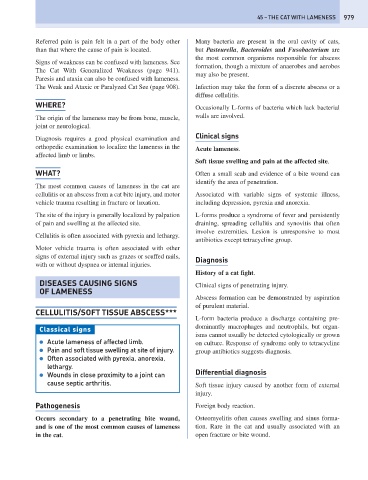Page 987 - Problem-Based Feline Medicine
P. 987
45 – THE CAT WITH LAMENESS 979
Referred pain is pain felt in a part of the body other Many bacteria are present in the oral cavity of cats,
than that where the cause of pain is located. but Pasteurella, Bacteroides and Fusobacterium are
the most common organisms responsible for abscess
Signs of weakness can be confused with lameness. See
formation, though a mixture of anaerobes and aerobes
The Cat With Generalized Weakness (page 941).
may also be present.
Paresis and ataxia can also be confused with lameness.
The Weak and Ataxic or Paralyzed Cat See (page 908). Infection may take the form of a discrete abscess or a
diffuse cellulitis.
WHERE? Occasionally L-forms of bacteria which lack bacterial
The origin of the lameness may be from bone, muscle, walls are involved.
joint or neurological.
Clinical signs
Diagnosis requires a good physical examination and
orthopedic examination to localize the lameness in the Acute lameness.
affected limb or limbs.
Soft tissue swelling and pain at the affected site.
WHAT? Often a small scab and evidence of a bite wound can
identify the area of penetration.
The most common causes of lameness in the cat are
cellulitis or an abscess from a cat bite injury, and motor Associated with variable signs of systemic illness,
vehicle trauma resulting in fracture or luxation. including depression, pyrexia and anorexia.
The site of the injury is generally localized by palpation L-forms produce a syndrome of fever and persistently
of pain and swelling at the affected site. draining, spreading cellulitis and synovitis that often
involve extremities. Lesion is unresponsive to most
Cellulitis is often associated with pyrexia and lethargy.
antibiotics except tetracycline group.
Motor vehicle trauma is often associated with other
signs of external injury such as grazes or scuffed nails,
Diagnosis
with or without dyspnea or internal injuries.
History of a cat fight.
DISEASES CAUSING SIGNS Clinical signs of penetrating injury.
OF LAMENESS
Abscess formation can be demonstrated by aspiration
of purulent material.
CELLULITIS/SOFT TISSUE ABSCESS***
L-form bacteria produce a discharge containing pre-
dominantly macrophages and neutrophils, but organ-
Classical signs
isms cannot usually be detected cytologically or grown
● Acute lameness of affected limb. on culture. Response of syndrome only to tetracycline
● Pain and soft tissue swelling at site of injury. group antibiotics suggests diagnosis.
● Often associated with pyrexia, anorexia,
lethargy.
● Wounds in close proximity to a joint can Differential diagnosis
cause septic arthritis. Soft tissue injury caused by another form of external
injury.
Pathogenesis Foreign body reaction.
Occurs secondary to a penetrating bite wound, Osteomyelitis often causes swelling and sinus forma-
and is one of the most common causes of lameness tion. Rare in the cat and usually associated with an
in the cat. open fracture or bite wound.

